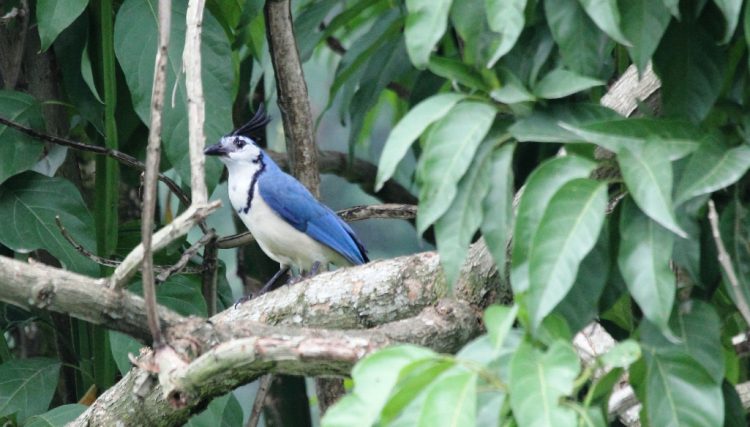One of the largest and most conspicuous songbirds in Guanacaste is the White-throated Magpie-Jay (Calocitta formosa). This social and vocal bird is normally seen in family groups of five to ten birds and is attractive. The blue body, white breast, exceptionally long blue tail, and tall, forward-curving topknot feathers on its head make it unmistakable.
The large Central American species of magpie-jay range in the Pacific-slope thorn forest from Jalisco, Costa Rica, and Mexico to Guanacaste. It is common in thorn forests, deciduous woodlands, gallery forests, forest edges, and cultivated areas like coffee plants.
Also, a closely related species, the Black-throated Magpie-Jay, is found in Mexico. The White-throated Magpie-Jay is found in savannas, dry forests, gallery forests, farmsteads, ranches, backyards, and woodlots. Roaming in family groups, these intelligent and omnivorous jays search for small lizards, caterpillars, frogs, beetles, grasshoppers, katydids, and cockroaches. Other foods include fruits, corn, eggs, nestlings of other birds, fruits, grains, seeds, the young of other birds, and the nectar of balsa (Ochroma) flowers. At La Ensenada Lodge, they boldly enter the open-air restaurant to pick up fallen food scraps. The nesting season occurs from February through July.

While incubating, the other family members visited along with the male, who all took turns feeding her. The young are fed by the parents, and the young are from previous broods. This magpie is omnivorous, consuming an extensive range of animal and plant matter. The juvenile birds take several years to acquire the full range of foraging skills of their parents. White-throated Magpie-Jay does not take on any migratory movements, though males disperse away from their natal territories a few years after fledging, and it is not considered threatened by human activities.

The White-throated Magpie-Jay can be found in Guanacaste’s NPS-Guanacaste, Palo Verde, Santa Rosa, and Las Baulas-and in the Lomas Barbuda!. It can also be seen at Sugar Beach, Tamarindo, Hacienda Solimar, La Ensenada Lodge, Playa Dofia Ana, La Pacifica, east to Hotel Borinquen Mountain Resort, and southeast to Tarcol Lodge at the mouth of the Rio Tarcoles. The white-throated magpie is a very noisy, gregarious bird, that mostly likes to travel with flocks, mobbing its observers. Here, you can listen to the sound of a white-throated magpie jay.
Read More – Cloud Cisticola
Facts:
Calocitta Formosa
Costa Rican names: Urraca copetona; urraca; piapia azul.
Status: Permanent resident.
length: 18 to 22 inches. (43 to 56cm)
Weight: 7.2 ounces (205 to 210 grams).
Range: Central Mexico to Costa Rica.
Elevational range: Sea level to 4,000 feet






